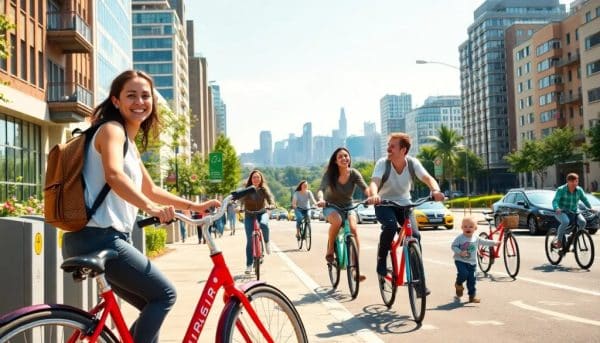As urban areas in the UK continue to grow, traffic congestion has become a pressing issue. The role of bike hire in reducing UK traffic congestion is increasingly recognized as a viable solution to this problem. This article explores how bike-sharing programs can alleviate traffic woes, enhance public health, and contribute to a sustainable future.
By offering a convenient and eco-friendly mode of transportation, bike hire schemes are not only transforming urban mobility but also fostering a culture of cycling that benefits everyone.
How do public bike-shares enhance urban mobility?
Public bike-share schemes have become a cornerstone of urban mobility, integrating seamlessly with existing public transport systems. These programs allow users to easily access bicycles at various docking stations throughout the city, promoting cycling as a viable alternative to car travel.
The flexibility of bike-share programs supports short-distance commuting, making it easier for residents to reach their destinations quickly and efficiently. This is especially beneficial in congested areas where traditional transport options may be limited.
Furthermore, the growing availability of bike lanes encourages cycling and helps ensure safer environments for cyclists. By investing in cycling infrastructure, cities can significantly enhance the overall cycling experience.
- Increased accessibility to public transport
- Reduction in travel times for short distances
- Promotion of a healthy lifestyle through physical activity
Ultimately, bike-share schemes exemplify how public transport integration can effectively enhance urban mobility.
What are the key benefits of bike hire schemes?
Bike hire schemes offer a multitude of benefits that extend beyond simply providing access to bicycles. One of the most significant advantages is the reduction of traffic congestion in urban environments. By encouraging more people to cycle instead of driving, these programs help to free up road space.
Moreover, bike hire schemes contribute to environmental sustainability by decreasing greenhouse gas emissions. Statistics show that cycling produces significantly lower emissions compared to motor vehicles, making it a green alternative.
Another important aspect is the economic impact. Bike hire schemes can stimulate local economies by attracting tourists and promoting businesses along popular cycling routes.
- Improved air quality
- Enhanced local economies
- Reduced travel costs for users
Overall, the advantages of bike hire schemes are extensive, making them a key player in the movement towards sustainable urban transportation.
How do Belfast Bikes promote sustainable transport?
Belfast Bikes, launched in April 2015, serves as an exemplary model of a successful bike hire scheme. With over 778,000 journeys recorded, this program has significantly contributed to promoting sustainable transport in the city.
Utilizing advanced technologies such as GPS and solar energy, Belfast Bikes not only facilitates cycling but also enhances the user's experience through efficient bike tracking and maintenance.
Additionally, the scheme has been beneficial for public health. By encouraging cycling, it helps reduce reliance on cars, promoting a healthier lifestyle among residents.
- Over 1.2 million kilometers cycled
- 46 docking stations across the city
- Supports diverse user groups, including tourists and locals
Ultimately, Belfast Bikes demonstrate the significant role of bike hire in enhancing urban livability and sustainability.
What technologies support modern bike hire systems?
Modern bike hire systems leverage a range of innovative technologies to enhance user experience and operational efficiency. For instance, many programs employ smartphone applications that allow users to locate nearby bikes, check availability, and make reservations.
GPS tracking is another critical technology that enables real-time monitoring of bike locations and usage patterns. This data can help city planners make informed decisions regarding cycling infrastructure development.
Moreover, advancements in payment systems, such as contactless payments and NFC technology, facilitate seamless transactions for users. This convenience can encourage more individuals to opt for bike hire as their preferred mode of transport.
- Smartphone apps for easy access
- GPS tracking for operational efficiency
- Contactless payment systems for user convenience
These technologies not only make bike hire more accessible but also ensure that cycling remains a practical and attractive option for urban mobility.
How do bike hire schemes contribute to public health?
Bike hire schemes play a pivotal role in promoting public health by encouraging increased physical activity among urban populations. Regular cycling contributes to better fitness levels and can help reduce the risk of various health issues.
Furthermore, by decreasing traffic congestion and associated air pollution, these schemes contribute to improved air quality. Clean air is essential for ensuring a healthy urban environment, which positively affects the well-being of residents.
Research indicates that cities with active bike hire programs often see lower rates of obesity and related health problems, underscoring the importance of cycling in urban public health strategies.
- Encouragement of regular physical activity
- Reduction in respiratory diseases linked to air pollution
- Promotion of mental well-being through outdoor activity
In summary, the health benefits associated with bike hire schemes are significant and far-reaching.
What are the environmental impacts of bike hire in cities?
The environmental effects of bike hire schemes are overwhelmingly positive. By reducing the number of cars on the road, bike hire significantly lowers carbon emissions, contributing to the fight against climate change.
Moreover, cycling is a sustainable mode of transport that requires minimal resources compared to motor vehicles. In cities where bike hire is promoted, there is often a marked decrease in air and noise pollution, which enhances the overall quality of life.
As more individuals choose cycling over driving, cities can expect to see substantial improvements in urban green spaces and biodiversity, as fewer vehicles mean less land dedicated to parking and roadways.
- Decreased greenhouse gas emissions
- Improved urban air quality
- Enhanced biodiversity through reduced land use for vehicles
Consequently, these environmental benefits illustrate the essential role bike hire schemes play in creating sustainable urban environments.
How can bike share programs reduce inequality in urban transport?
Bike share programs can be instrumental in addressing inequalities in urban transport by providing affordable and accessible transportation options for underserved communities. Many low-income areas lack efficient public transport, making bike hire a vital alternative.
These programs often offer subsidized rates or free access for individuals in lower-income brackets, ensuring that cycling is a viable option for everyone. By increasing access to transportation, bike share schemes can empower marginalized groups and improve their mobility.
Furthermore, collaboration between public authorities and private operators can enhance the reach and impact of bike share programs, ensuring they cater to diverse user needs.
- Subsidized fees for low-income users
- Partnerships with local organizations for outreach
- Increased focus on accessibility features in bike design
Ultimately, bike share programs have the potential to play a significant role in reducing transport inequalities and fostering inclusive urban mobility.
Related questions about bike hire and urban transport
How do cycle lanes reduce traffic congestion?
Cycle lanes are designed to separate cyclists from motor traffic, creating safer and more inviting environments for cycling. This separation encourages more individuals to choose cycling as a mode of transport, ultimately reducing the number of cars on the road.
By promoting cycling, cities can effectively manage traffic flow and decrease congestion levels, particularly during peak hours. Well-planned cycle lanes also enhance the overall cycling experience, making it an attractive alternative to driving.
What are the benefits of using a bike for transportation?
Biking offers numerous benefits, including cost savings, health improvements, and environmental advantages. It is a low-cost mode of transport, eliminating fuel costs and parking fees.
Additionally, cycling promotes cardiovascular health and reduces the risk of lifestyle-related diseases, while also contributing to lower carbon emissions. These benefits make biking an appealing choice for individuals looking to improve their quality of life.
What is the TfL cycling action plan?
The Transport for London (TfL) cycling action plan outlines strategies to promote cycling in the capital. This comprehensive plan includes initiatives to improve cycling infrastructure, enhance safety for cyclists, and increase public awareness of the benefits of cycling.
By investing in better cycling facilities and fostering a cycling culture, the TfL aims to significantly increase the number of cyclists in London, thus reducing traffic congestion and promoting sustainable transport.
What is the role of bike sharing stations in the perception of public spaces?
Bike sharing stations can positively alter the perception of public spaces by increasing foot traffic and promoting a vibrant urban environment. By integrating bike hire into public spaces, cities can encourage more people to explore their surroundings.
Furthermore, the presence of bike stations adds to the aesthetic appeal of urban areas, promoting a sense of community and encouraging social interactions. This transformation can lead to a more active and engaging public realm.


Leave a Reply